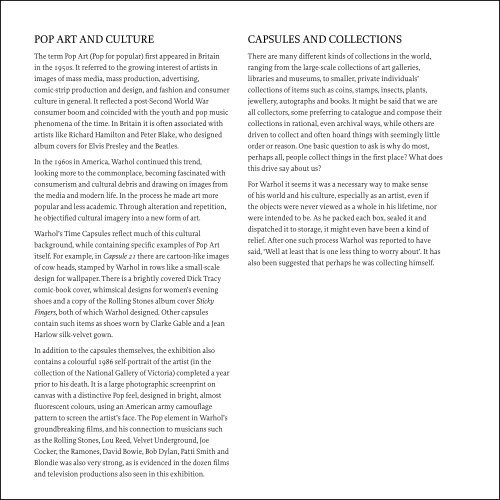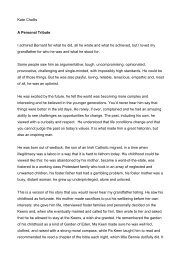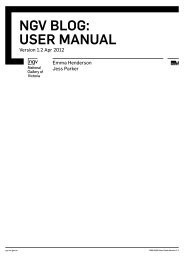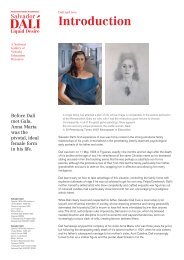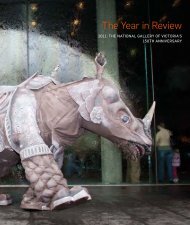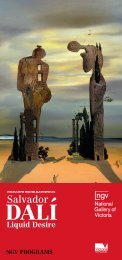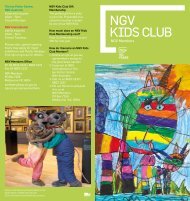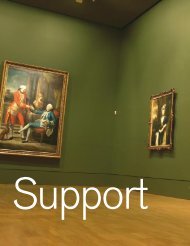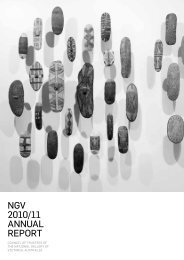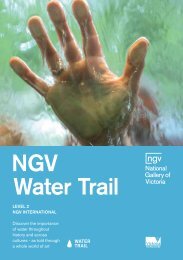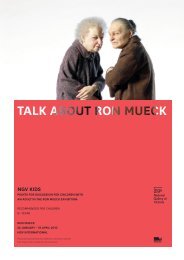Andy Warhol's Time Capsules (416.9 KB PDF) - National Gallery of ...
Andy Warhol's Time Capsules (416.9 KB PDF) - National Gallery of ...
Andy Warhol's Time Capsules (416.9 KB PDF) - National Gallery of ...
You also want an ePaper? Increase the reach of your titles
YUMPU automatically turns print PDFs into web optimized ePapers that Google loves.
POP ART AND CULTUREThe term Pop Art (Pop for popular) first appeared in Britainin the 1950s. It referred to the growing interest <strong>of</strong> artists inimages <strong>of</strong> mass media, mass production, advertising,comic-strip production and design, and fashion and consumerculture in general. It reflected a post-Second World Warconsumer boom and coincided with the youth and pop musicphenomena <strong>of</strong> the time. In Britain it is <strong>of</strong>ten associated withartists like Richard Hamilton and Peter Blake, who designedalbum covers for Elvis Presley and the Beatles.In the 1960s in America, Warhol continued this trend,looking more to the commonplace, becoming fascinated withconsumerism and cultural debris and drawing on images fromthe media and modern life. In the process he made art morepopular and less academic. Through alteration and repetition,he objectified cultural imagery into a new form <strong>of</strong> art.Warhol’s <strong>Time</strong> <strong>Capsules</strong> reflect much <strong>of</strong> this culturalbackground, while containing specific examples <strong>of</strong> Pop Artitself. For example, in Capsule 21 there are cartoon-like images<strong>of</strong> cow heads, stamped by Warhol in rows like a small-scaledesign for wallpaper. There is a brightly covered Dick Tracycomic-book cover, whimsical designs for women’s eveningshoes and a copy <strong>of</strong> the Rolling Stones album cover StickyFingers, both <strong>of</strong> which Warhol designed. Other capsulescontain such items as shoes worn by Clarke Gable and a JeanHarlow silk-velvet gown.CAPSULES AND COLLECTIONSThere are many different kinds <strong>of</strong> collections in the world,ranging from the large-scale collections <strong>of</strong> art galleries,libraries and museums, to smaller, private individuals’collections <strong>of</strong> items such as coins, stamps, insects, plants,jewellery, autographs and books. It might be said that we areall collectors, some preferring to catalogue and compose theircollections in rational, even archival ways, while others aredriven to collect and <strong>of</strong>ten hoard things with seemingly littleorder or reason. One basic question to ask is why do most,perhaps all, people collect things in the first place? What doesthis drive say about us?For Warhol it seems it was a necessary way to make sense<strong>of</strong> his world and his culture, especially as an artist, even ifthe objects were never viewed as a whole in his lifetime, norwere intended to be. As he packed each box, sealed it anddispatched it to storage, it might even have been a kind <strong>of</strong>relief. After one such process Warhol was reported to havesaid, ‘Well at least that is one less thing to worry about’. It hasalso been suggested that perhaps he was collecting himself.In addition to the capsules themselves, the exhibition alsocontains a colourful 1986 self-portrait <strong>of</strong> the artist (in thecollection <strong>of</strong> the <strong>National</strong> <strong>Gallery</strong> <strong>of</strong> Victoria) completed a yearprior to his death. It is a large photographic screenprint oncanvas with a distinctive Pop feel, designed in bright, almostfluorescent colours, using an American army camouflagepattern to screen the artist’s face. The Pop element in Warhol’sgroundbreaking films, and his connection to musicians suchas the Rolling Stones, Lou Reed, Velvet Underground, JoeCocker, the Ramones, David Bowie, Bob Dylan, Patti Smith andBlondie was also very strong, as is evidenced in the dozen filmsand television productions also seen in this exhibition.


